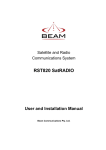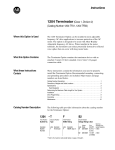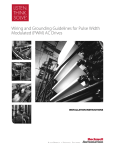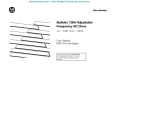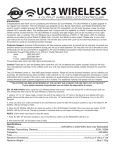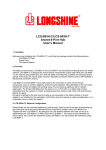Download Effective Motor Protection Against Reflected Wave Phenomenon
Transcript
Effective Motor Protection Against Reflected Wave Phenomenon 1204 Motor Terminator IGBT Drives & Motor Protection The use of IGBT (Insulated Gate Bipolar Transistor) devices in variable frequency AC drives has increased drive/motor performance and reduced physical size of new AC drive offerings. It has also brought a number of new installation issues to the forefront, including the phenomenon known as reflected wave. The Reflected Wave Phenomenon The most significant impact that can occur when using an IGBT drive is the occurrence of high voltage spikes at the motor terminals which can produce potentially destructive stress on the motor insulation. A phenomenon known as reflected wave, standing wave or transmission line effect occurs when a drive is installed with long cable runs between the drive and motor. It is a well documented issue in power distribution and digital communications and is now coming to the forefront in drive installations. The motor cables represent an impedance to the PWM voltage pulses from the drive. These cables contain significant values of inductance and capacitance that are directly proportional to their length. The cable surge impedance is defined as the square root of the value that results when inductance per unit length is divided by capacitance per unit length (Z = √L/C). Whenever this cable surge impedance does not match the surge impedance of the motor, a reflected wave will occur. The velocity of this wave (dependent on cable capacitance and inductance) plus the rise time of the switching device determines the distance at which the reflected wave will reach its maximum amplitude. Unterminated 1264 Volts Reactor 1032 Volts It is important to understand that this reflection occurs regardless of the type of switching device employed by the drive. IGBT, GTO (Gate Turn Off) and BJT (Bipolar Junction Transistor) device installations all experience the reflected wave phenomenon. This amplitude can be 2 to 3 times the drive DC bus voltage (in excess of 2400 Volts for a 575 Volt system). The peak value and rise time of the reflected voltage waveform can have significant impact on the insulation inside the motor. While only a small portion of installations are affected, solutions must be offered. The Effects on the Motor The current “machine wind, dip & bake” method used to build many of today’s motors typically leaves both mechanical stress cracks in the enamel wire insulation and microscopic voids in the insulation coating. These holes and cracks can become insulation failure points when voltage peaks are impressed on the stator winding by the reflected wave phenomenon. Small motors (0.5-5 Hp) are generally at higher risk because phase paper is either absent or rendered inadequate by the forming process. Terminated 888 Volts DC Bus 200 Volts / Div 0 5.00 µS / Div The waveforms at the left show the amplitude of reflected wave at the motor terminals under three conditions. The unterminated waveform has a VL-L (PK) of 1264V and is potentially destructive to a motor. The reactor waveform shows a reduced VL-L (PK) of 1032V, acceptable for most motors. The terminator waveform shows a VL-L (PK) clamped at 888 Volts to remove any effects of reflected wave from the motor. Reflected Wave Amplitude at the Motor Terminals While conclusive data is not available to determine the exact cause of insulation failure, it is generally agreed that one of the following situations will occur: 2000 Peak Line - LineVoltage (Volts) 1800 1. The electrical stress voltage will exceed the breakdown voltage of the air and a partial discharge will occur. Successive partial discharges will degrade the insulation slowly. 1600 1400 1200 1000 800 600 400 200 2. The voltage will ionize the surrounding air and lead to arcing across the windings (a process known as corona or corona discharge), causing more rapid motor failure. 0 0.00 0.20 0.40 0.60 0.80 1.00 1.20 1.40 1.60 1.80 2.00 2.20 2.40 NEMA MG1-Part 31 motor insulation, which is the same as a 460 Volt motor. While a number of cases of motor failures have been documented with the use of BJT and GTO based drives, they were generally restricted to longer motor cables (180m/600 ft. and up). This is understandable when we remember that the rise time of the switching device determines the distance at which the reflected wave amplitude will reach its maximum. The rise time of a typical BJT (0.2 - 2 µS) or GTO (2 - 4 µS) is an order of Why IGBT Drives? While this phenomenon has been present for many years, it has come to the forefront with the introduction of 460 Volt and 575 Volt IGBT based drives. For the most part, 230 Volt applications are unaffected because the reflected wave amplitudes are lower than the typical 10 100 1000 Motor Overvoltage / Bus Voltage 10000 Cable Distance (m) 2.2 Semiconductor Risetime 50 ns 200 ns 400 ns 2 µs 4 µs 2 1.8 1.6 1.4 1.2 Cable Distance (ft) 1 1 10 100 IGBT IEEE 460 V IEEE 575V Motor Dielectric Withstand Envelope 3. The voltage is greater than the magnet wire insulation volts/mil value, causing dielectric stress and eventual insulation failure. 1 Rise Time @ Motor [µS] Brand A Brand B 1000 10000 BJT GTO Motor Overvoltage vs. Semiconductor Risetime magnitude higher than that of today’s 3rd generation IGBTs (50 - 400 nS), allowing much longer motor cable lengths before the maximum allowable peak motor voltage is reached. Even earlier generation IGBTs do not have the fast rise times of their present day counterparts. As the advantages (increased carrier frequency with minimal power loss) of the faster rise time devices have been realized, their use in drive construction has increased. This has brought a focus on the increase in motor issues. Installing a current generation IGBT drive under the same conditions as an earlier drive can amplify the reflected wave phenomenon and its resultant motor failures. While the IGBT did not create the problem, its fast rise time has made users more aware of the issues by increasing the frequency of failures. Drive manufacturers have included both hardware & software in their designs to reduce reflected wave amplitudes, but even those solutions are only partial solutions. The Allen-Bradley 1204 Terminator offers a cost effective solution for motor protection against reflected wave. Product Description The Solution . . . The 1204 Terminator Simplicity . . . The 1204 Terminator can be connected to any standard motor to provide a simple solution in helping to protect motors from premature failure due to reflected wave impulses. An integral connection cable is provided to simplify installation — just install the Terminator and operate your drive . . . No customer start-up or adjustment is necessary. Flexibility . . . . . . Just two versions of the 1204 Terminator cover most installations 380V to 600V motors. .37 to 485 kW (.5 to 650 HP) motors. Cable lengths up to 335 meters (1100 feet). Terminators can be used with a wide variety of motor cables including shielded cables. They can be located in a number of configurations relative to the motor to offer installation flexibility in many applications. To cover the majority of applications, the Terminators will handle both single motor and multi-motor installations Performance . . . The Terminator is an effective tool in helping to prevent premature motor insulation breakdown due to the stresses of reflected wave impulse peaks . . . When connected to any horsepower motor, the Terminator reduces the peak voltages caused by reflected wave phenomenon to a level that can help keep even the lowest rated motors safe from the effects of corona and insulation failure. The Terminator can be installed with little concern over mismatches in motor-cable surge impedance that are sometimes found with other solutions. Terminators have little or no effect on the quality of the waveforms in the motor and do not introduce voltage drops that can reduce available motor torque. 1204 Motor Terminator . . . Effective protection against reflected wave. (Class 1, Division 2) Table of Contents Product Specifications and Dimensions Product Pre-Installation Product FAX Form 1204 Motor Terminator Product Specifications and Dimensions The following specifications and dimensions apply to the 1204 Terminator. Specifications Input Power Maximum Drive Carrier Frequency Ambient Temperature Humidity Atmosphere TFA1 — 380-600V/3ø TFB2 — 380-600V/3ø TFA1 — 6 kHz TFB2 — 2 kHz If the PWM frequency is greater than the maximum drive carrier frequency, re-program the drive to a value less than or equal to the maximum drive carrier frequency. 0-40°C (32-104°C) 5-95% non-condensing Class 1, Div. 2 Heat Dissipation (45°C Ambient) 1204-TFA1 Terminator meters (feet) 91 (300) 183 (600) 6 kHz Watts Heatsink Temp 210 150°C 250 169°C 4 kHz Watts Heatsink Temp 170 133°C 180 138°C 2 kHz Watts Heatsink Temp 80 95°C 90 104°C Drive Frequency Enclosure Type Agency Certification Altitude Derating 1204-TFB2 Terminator 91 (300) 183 (600) 91 (300) 183 (600) MUST USE 2 kHZ 200 139°C 250 160°C 290 182°C 360 215°C NEMA Type 4 (IP65) U.L. Listed Full rating (0-1000m) Ambient 40°C Temperature Limit 35°C Hazardous Environment Rating T3 (200ºC) Groups A, B, C, D 30°C 0 Altitude 1,000 (3,300) 2,000 (6,600) 3,000 (9,900) Dimensions 4,000 m (13,200) (ft) 182.9 (7.20) 6.35 (.25) 170.2 (6.70) 14.22 (.56) 88.9 (3.50) Allen-Bradley SIDE Bulletin 1204-TFB2 Series A AC Drive HP 2 TO 800 Voltage 380 TO 600 VAC Max. Carrier Freq. 2 KHz Type 4X Enclosure Hazardous Locations Class I, Division 2 Groups A, B, C, D Temperature Code T3 (200°c) 158.75 (6.25) 117.86 (4.64) C UL ® US LISTED IND. CONT. EQ. FOR USE IN HAZ. LOC. 8AA4 127 (5.00) Assembled in Mexico 155.5 (6.12) DANGER CAN CAUSE SHOCK, BURNS, OR DEATH DISCONNECT AND LOCKOUT ALL POWER SOURCES BEFORE SERVICING SURFACES MAY BE HOT ALLOW TO COOL BEFORE SERVICING BOTTOM Dimensions are given in millimeters and (inches). The terminator weighs 3.86 kilograms (8.5 pounds). Motor Terminator FRONT See Instruction Manual For Mounting Instructions Approximately 1371 (120) (4) Slots for M4 Hardware Out-Going Cable Product Pre-Installation Determine the maximum cable length for your system. Use the following tables to determine the maximum cable length for your system. The values shown are for nominal input voltage and a drive carrier frequency of 2 kHz. If you plan to operate your system at carrier frequencies above 2 kHz , consult the factory. As detailed in the Product Specifications, increasing the carrier frequency will increase watt dissipation and surface temperature. It may also affect cable capacitance and charging current for drives below 7.5 HP. If you are running at high-line conditions, input voltage can be up to 10% greater than the drive’s nominal rated input voltage , multiply the cable length value by 0.85. Type A Motor Characteristics: No phase paper or misplaced phase paper, lower quality insulation systems, corona inception voltages between 850 and 1000 volts. Properly placed phase paper, medium quality insulation systems, corona inception voltages between 1000 and 1200 volts. These AC variable speed motors are power matched for use with Allen-Bradley drives. Each motor is energy efficient and designed to meet or exceed the requirements of the Federal Energy Act of 1992. All 1329R/L motors are optimized for variable speed operation and include premium inverter grade insulation systems which meet or exceed NEMA MG1.Part31.40.4.2. Type B Motor Characteristics: 1329R/L Motors: Maximum Motor Cable Length Restrictions for 1305 Drives in meters and (feet). Drive HP (460V) Motor HP (460V) 0.5 0.5 1 0.5 With 1204-TFB2 Terminator With 1204-TFA1 Terminator Motor Type A or B Type A Motor Shielded Unshielded Unshielded 76m (250ft) 61m (200ft) 76m (250ft) 121m (400ft) 45m (150ft) 61m (200ft) 45m (150ft) 76m (250ft) 0.5 91m (300ft) 121m (400ft) 99m (325ft) 61m (200ft) 152m (500ft) 121m (400ft) 61m (200ft) 61m (200ft) 99m (325ft) 61m (200ft) 121m (400ft) 121m (400ft) Not Recommended 1 91m (300ft) 182m (600ft) 2 91m (300ft) 121m (400ft) 3 5 Shielded 1 2 3 Unshielded Not Recommended 91m (300ft) 61m (200ft) 91m (300ft) 121m (400ft) 99m (325ft) 61m (200ft) 182m (600ft) 121m (400ft) 99m (325ft) 61m (200ft) 152m (500ft) 121m (400ft) 91m (300ft) 61m (200ft) 91m (300ft) 121m (400ft) 2 121m (400ft) 182m (600ft) 99m (325ft) 61m (200ft) 182m (600ft) 121m (400ft) 3 91m (300ft) 121m (400ft) 99m (325ft) 61m (200ft) 152m (500ft) 121m (400ft) 91m (300ft) 61m (200ft) 91m (300ft) 121m (400ft) 5 With Allen-Bradley 1329R/L Motors Not Recommended Not Recommended 1 2 Type B Motor Shielded Not Recommended For applications/ installations using new motors, no restrictions in lead length due to voltage reflection are necessary. You should observe standard practices for voltage drop, cable capacitance, and other issues. Product Pre-Installation Maximum Motor Cable Length Restrictions for 380-480 Volt 1336 PLUS II, 1336 IMPACT ™ and 1336 FORCE™ Drives in meters and (feet). Drive Drive kW (hp) Frame Motor kW (hp) With 1204-TFB2 Terminator With 1204-TFA1 Terminator Motor Motor Type A or B Type A Type B Cable Type Cable Type Cable Type Shielded 1 A1 A2 0.37 (0.5) 0.75 (1) 1.2 (1.5) 1.5 (2) 2.2 (3) A3 A4 B C D E F G H 1 3.7 (5) 5.5-7.5 (7.5-10) 5.5-22 (7.5-30) 30-45 (X40-X60) 45-112 (60-X150) 112-187 (150-250) 187-336 (250-450) 187-448 (X250-600) 522-597 (700-800) 0.37 (0.5) 0.75 (1) 0.37 (0.5) 1.2 (1.5) 0.75 (1) 0.37 (0.5) 1.5 (2) 1.2 (1.5) 0.75 (1) 0.37 (0.5) 2.2 (3) 1.5 (2) 0.75 (1) 0.37 (0.5) 3.7 (5) 2.2 (3) 1.5 (2) 0.75 (1) 0.37 (0.5) 5.5-7.5 (7.5-10) 5.5-22 (7.5-30) 30-45 (40-60) 45-112 (60-150) 112-224 (150-300) 187-336 (250-450) 187-448 (250-600) 522-597 (700-800) With Allen-Bradley 1329R/L Motors Unshielded Shielded 1 30.5 (100) 30.5 (100) 30.5 (100) 30.5 (100) 30.5 (100) 30.5 (100) 30.5 (100) 30.5 (100) 30.5 (100) 30.5 (100) Use the 1204-TFA1 Terminator or 1329R/L Motor 91.4 (300) 91.4 (300) 182.9 (600) 182.9 (600) 182.9 (600) 182.9 (600) 182.9 (600) 182.9 (600) 182.9 (600) 182.9 (600) 182.9 (600) 182.9 (600) 182.9 (600) 182.9 (600) 182.9 (600) 182.9 (600) 182.9 (600) 182.9 (600) 182.9 (600) 182.9 (600) 182.9 (600) 91.4 (300) 182.9 (600) 182.9 (600) 182.9 (600) 182.9 (600) 182.9 (600) 182.9 (600) 182.9 (600) 182.9 (600) 182.9 (600) 182.9 (600) 182.9 (600) 182.9 (600) 182.9 (600) 182.9 (600) 182.9 (600) 182.9 (600) 182.9 (600) 182.9 (600) 182.9 (600) 182.9 (600) Unshielded 61.0 (200) 30.5 (100) 61.0 (200) 30.5 (100) 30.5 (100) 30.5 (100) 30.5 (100) 30.5 (100) 30.5 (100) 30.5 (100) Shielded 1 30.5 (100) 30.5 (100) 30.5 (100) 61.0 (200) 61.0 (200) 61.0 (200) 91.4 (300) 91.4 (300) 91.4 (300) 91.4 (300) Unshielded 61.0 (200) 30.5 (100) 61.0 (200) 61.0 (200) 61.0 (200) 61.0 (200) 61.0 (200) 61.0 (200) 61.0 (200) 61.0 (200) For applications/ installations using new motors, no restrictions in lead length due to voltage reflection are necessary. You should observe standard practices for voltage drop, cable capacitance, and other issues. Use the 1204-TFB2 Terminator or 1329R/L Motor Includes wire in conduit Maximum Motor Cable Length Restrictions for 500-600 Volt 1336 PLUS II, 1336 IMPACT ™ and 1336 FORCE™ Drives in meters and (feet). Drive Frame Drive kW (HP) A4 0.75 (1) 1.5 (2) 2.2 (3) Motor kW (HP) With 1204-TFA1 Terminator Motor Motor With Allen-Bradley 1329R/L Motors Type A Type B 1329R/L Type A Type B Any Cable Any Cable Any Cable Any Cable Any Cable Any Cable 0.75 (1) 182.9 (600) 335.3 (1100) 61.0 (200) 182.9 (600) 0.37 (0.5) 182.9 (600) 335.3 (1100) 61.0 (200) 182.9 (600) 1.5 (2) 182.9 (600) 335.3 (1100) 61.0 (200) 182.9 (600) 1.2 (1.5) 182.9 (600) 335.3 (1100) 61.0 (200) 182.9 (600) 0.75 (1) 182.9 (600) 335.3 (1100) 61.0 (200) 182.9 (600) 0.37 (0.5) 182.9 (600) 335.3 (1100) 61.0 (200) 182.9 (600) 2.2 (3) 182.9 (600) 335.3 (1100) 61.0 (200) 182.9 (600) 335.3 (1100) 61.0 (200) 182.9 (600) 1.5 (2) 3.7 (5) With 1204-TFB2 Terminator Not Recommended 182.9 (600) 0.75 (1) 182.9 (600) 335.3 (1100) 61.0 (200) 182.9 (600) 0.37 (0.5) 182.9 (600) 335.3 (1100) 61.0 (200) 182.9 (600) 3.7 (5) 182.9 (600) 335.3 (1100) 182.9 (600) 2.2 (3) 182.9 (600) 335.3 (1100) Not 61.0 (200) Recommended 61.0 (200) 1.5 (2) 182.9 (600) 335.3 (1100) 61.0 (200) 182.9 (600) 0.75 (1) 182.9 (600) 335.3 (1100) 61.0 (200) 182.9 (600) 0.37 (0.5) 182.9 (600) 335.3 (1100) 61.0 (200) 182.9 (600) 182.9 (600) B 5.5-15 (7.5-20) 5.5-15 (7.5-20) 91.4 (300) 182.9 (600) 61.0 (200) 182.9 (600) C 18.5-45 (25-60) 18.5-45 (25-60) 91.4 (300) 182.9 (600) 61.0 (200) 182.9 (600) D 56-93 (75-125) 56-93 (75-125) 91.4 (300) 182.9 (600) E 112-224 (150-X300) 112-224 (150-X300) 91.4 (300) 182.9 (600) F 187-336 (250-450) 187-336 (250-450) 91.4 (300) 182.9 (600) G 224-448 (300-600) 224-448 (300-600) 91.4 (300) 182.9 (600) H 522-597 (700-800) 522-597 (700-800) 91.4 (300) 182.9 (600) Not Available at Time of Printing 61.0 (200) 182.9 (600) 61.0 (200) 182.9 (600) 61.0 (200) 182.9 (600) 61.0 (200) 182.9 (600) 61.0 (200) 182.9 (600) PowerFlex 70/700/700H/700S. See reference manuals Publication # PFLEX-RM001/RM002, www.rockwellautomation.com/literature Product Pre-Installation Grounding your system. Follow the recommended grounding practices provided in your Allen-Bradley AC Drive User Manual. The following illustration shows an example of the system grounding practices. Motor Terminator Conduit/4-Wire Cable Motor Mounted Junction Box R (L1) U (T1) S (L2) Motor Terminator Bulletin 1204-TFB2 Series A AC Drive HP .5 to 600 Voltage 380-600 VAC Carrier Freq. ≤ 2 KHz D9 LISTE 66X UL ® IN D CONT EQ D9 LISTE 66X C UL ® IN D C ONT EQ Made in U.S.A. DANGER CAN CAUSE SHOCK, BURNS, OR DEATH DISCONNECT AND LOCKOUT ALL POWER SOURCES BEFORE SERVICING SURFACES MAY BE HOT ALLOW TO COOL BEFORE SERVICING ESC V (T2) SEL JOG T (L3) Allen-Bradley See Instruction Manual For Mounting Instructions W (T3) PE/Gnd. PE PE (Motor Frame) Ground per Local Codes Nearest Building Structure Steel If you cannot connect the terminator directly to the motor mounted junction box, you can use an auxiliary junction box. You should keep the Terminator-to-motor connection to a maximum length of 8 meters (26.25 feet). The Automation Investment Life Cycle™ Plant-floor automation has become a dynamic cycle in which each piece of equipment purchased has to simultaneously meet current needs and anticipate future upgrades. Allen-Bradley drives are specifically engineered with this dual purpose in mind. The Automation Investment Life Cycle ensures that your investment in Allen-Bradley automation equipment delivers the long-term productivity benefits you want. Life cycle planning provides a framework that helps you reduce costs and anticipate needs throughout the life of your automation investment. Justify Initial planning and justification by Allen-Bradley engineers and distributors lays the foundation for a successful long-term automation investment strategy and identifies motor control requirements. Apply Application and sales engineers work with you to identify the right drive for each motor. Strong commonality across the Allen-Bradley drives family simplifies the application stage for even the most complex motor control requirements. Install Taking advantage of the wide variety of Allen-Bradley drive packaging options to ease installation, an experienced engineering team assists you with all aspects of system start up. Operate Thoughtful planning and installation translate to simple and cost-effective operation. Sophisticated programming tools and the proven reliability of Allen-Bradley drives allow for dependable, unsupervised operation that will help you meet productivity and performance goals. Maintain Complete parts repair service and inventory management from Allen-Bradley Global Technical Services, coupled with the built-in troubleshooting capabilities of Allen-Bradley drives, simplify maintenance and enhance productivity. Improve The built-in expandability and flexibility of Allen-Bradley drives protects your automation investment by allowing you to take advantage of design improvements and technological innovations. Today’s manufacturers must build greater flexibility into their automation systems to meet ever-changing customer demands for more products at reduced cost and in less time. This era of flexibility and low cost is changing what used to be viewed as one-time automation purchases to long-term productivity benefits. Allen-Bradley calls this the Automation Investment Life Cycle. Beyond the initial purchase price, Allen-Bradley is helping manufacturers and processors understand and reduce costs associated with justifying, applying, installing, operating, maintaining and upgrading their automation system. For devices. For complete automated systems. The Automation Investment Life Cycle, The Automation Investment Life Cycle Symbol, 1336 IMPACT and 1336 FORCE are trademarks of Allen-Bradley Co., Inc. Allen-Bradley, a Rockwell automation business, has been helping its customers improve productivity and quality for more than 90 years. We design, manufacture and support a broad range of automation products worldwide. They include logic processors, power and motion control devices, operator interfaces, sensors and a variety of software. Rockwell is one of the world’s leading technology companies. Argentina • Australia • Austria • Bahrain • Belgium • Brazil • Bulgaria • Canada • Chile • China, PRC • Colombia • Costa Rica • Croatia • Cyprus • Czech Republic • Denmark Ecuador • Egypt • El Salvador • Finland • France • Germany • Greece • Guatemala • Honduras • Hong Kong • Hungary • Iceland • India • Indonesia • Ireland • Israel • Italy Jamaica • Japan • Jordan • Korea • Kuwait • Lebanon • Malaysia • Mexico • Netherlands • New Zealand • Norway • Pakistan • Peru • Philippines • Poland • Portugal Puerto Rico • Qatar • Romania • Russia–CIS • Saudi Arabia • Singapore • Slovakia • Slovenia • South Africa, Republic • Spain • Sweden • Switzerland • Taiwan • Thailand Turkey • United Arab Emirates • United Kingdom • United States • Uruguay • Venezuela • Yugoslavia Allen-Bradley Headquarters, 1201 South Second Street, Milwaukee, WI 53204 USA, Tel: (1) 414 382-2000 Fax: (1) 414 382-4444 Publication 1204 -1.0 – January 1998 Supersedes Publication 1204-1.0 – April 1997 ©1996 Allen-Bradley Co. Printed USA












